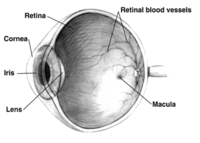
Photo from wikipedia
Abstract Retinal ganglion cells (RGCs), the sole output cells of the retina, are a heterogeneous population of neurons that project axons to visual targets in the brain. Like most CNS… Click to show full abstract
Abstract Retinal ganglion cells (RGCs), the sole output cells of the retina, are a heterogeneous population of neurons that project axons to visual targets in the brain. Like most CNS neurons, RGCs are considered incapable of mounting long distance axon regeneration. Using immunolabeling-enabled 3D imaging of solvent-cleared organs (iDISCO) in transgenic mice, we tracked the entire paths of individual RGC axons and show that adult RGCs are highly capable of spontaneous long-distance regeneration, even without any treatment. Our results show that the Thy1-H-YFP mouse sparsely labels RGCs, consisting predominantly of regeneration-competent α-type RGCs (αRGCs). Following optic nerve crush, many of the YFP-labeled RGC axons extend considerable distances proximal to the injury site with only a few penetrating through the lesion. This tortuous axon growth proximal to the lesion site is even more striking with intravitreal ciliary neurotrophic factor (CNTF) treatment. We further demonstrate that despite traveling more than 5 mm (i.e., a distance equal to the length of mouse optic nerve), many of these circuitous axons are confined to the injury area and fail to reach the brain. Our results re-evaluate the view that RGCs are naturally incapable of re-extending long axons, and shift the focus from promoting axon elongation, to understanding factors that prevent direct growth of axons through the lesion and the injured nerve.
Journal Title: eNeuro
Year Published: 2017
Link to full text (if available)
Share on Social Media: Sign Up to like & get
recommendations!